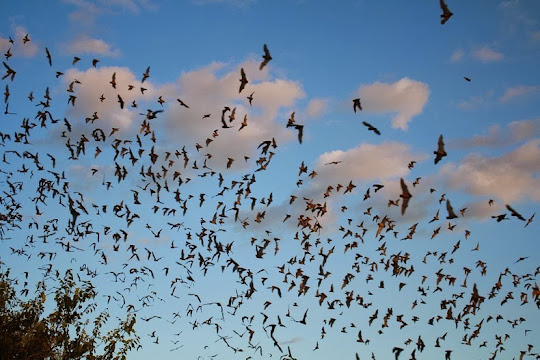Every night from March to October, these tiny creatures fly out of the 100-foot-wide crescent-shaped opening to feed. The bats’ exodus is slow at first as they linger at the cave’s lip, circling round and round inside before emerging. Over the next four hours, millions and millions of bats stream out of the cave in graceful swirls as they rise into the wide sky and dissipate in the distance. They spread out over a 60-mile radius from the cave at heights of up to 10,000 feet and over the next 8 to 12 hours feed on hundreds of tons of insects, such as moths and agricultural pests. Their emergence is so dense that it shows up on Doppler radar, according to TexasCoopPower.com. Those who have seen the bats’ nightly emergence have described the sound they generate as that of steadily falling rainstorm.

Besides tourists and bat lovers, a host of other creatures expectantly wait for their exit. Great Horned Owl and Harris’s Hawks scope out potential dinners from nearby trees, while skunks, raccoons, opossums and rattlesnakes lurk on the ground to strike low-flying bats from the air.
The Bracken bat colony consumes tons of insects each night and plays an important role in pest control, helping farmers control moths, beetles and insects that destroy corn, cotton and other crops. The Bracken site has had a significant role in Texas and US history. The cave was mined in the 1860s for guano (bat droppings) to manufacture black gunpowder, during the Civil War. The guano was later used as a rich fertilizer for croplands across the United States.
The bat cave sits upon private land owned by Bat Conservation International that owns 697 acres of undeveloped land around it. Access to the cave is restricted to protect the habitat of the resident bats, but evening guided tours to the cave are offered to watch the bats emerge from the cave.













Source
